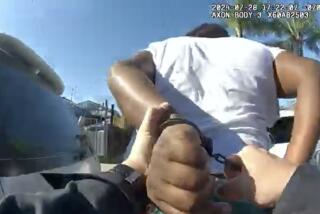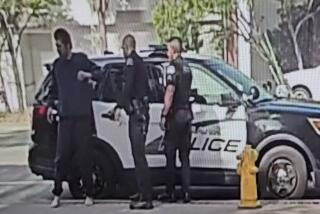Social media are reshaping policing and conversations about violence
- Share via
The two men lay motionless on the sidewalk outside a South L.A. carwash, pools of blood spilling from their heads. With the paramedics still on their way, people crowded around the men and pulled out their phones.
Before detectives arrived, an image had been posted to Instagram, then circulated on Facebook and Twitter.
One man would live, but the family of the man who died found out about it through the graphic photo.
For some, the photo — and its distribution — was a brazen, inappropriate act. The next day, members of a City Council committee on gangs and public safety denounced the posting.
“It was just disgusting. It was just immoral,” Councilman Joe Buscaino, a former police officer, told the committee.
But the photo also is an example of how social media is changing policing — and how people in communities such as South L.A. are reacting to violence.
Just as social media can help investigators, it can also be a hindrance. Recently, when a man was killed in South L.A., rumors of retaliatory violence spread through the hashtag #100days100nights, creating a frenzy that officers had to tamp down. And the photo of the man killed outside the carwash, 23-year-old Delshon Hayes, again made social media part of the conversation in the community.
“I think people are getting more brave with it,” said LAPD Det. Young Mun, who is investigating Hayes’ killing.
Although people posting graphic images on social media is nothing new, Mun said the photo of Hayes was the first time that he had arrived at a homicide scene after a photograph had already been posted.
“It went up there really fast,” he said.
South Bureau Commander Phil Tingirides with the Los Angeles Police Department said the agency tries to monitor gang activity and related postings on the Internet. In addition, social media has “absolutely changed” the process of death notifications.
In some neighborhoods, family members will anticipate a homicide detective’s arrival — they’ve already found out through text messages or Facebook.
“The days of going up and knocking on somebody’s door in a community like Los Angeles … those days are so far gone,” Tingirides said.
What people post to social media could also signal how desensitized some are to violence, said David Pyrooz, an assistant professor of sociology at the University of Colorado who has studied social media and gangs.
Pyrooz said it has become normal to pull out a phone any time there’s some sort of action.
“There’s no rules when it comes to your everyday citizen when you’re posting things on Twitter,” he said.
Social media companies have varying policies with graphic images. According to Twitter’s policy, the company will remove imagery of bodies in “certain circumstances.” Family members and other “authorized individuals” can ask for images to be removed by filling out a privacy form.
According to Facebook’s policy, the company takes the context of a post into account. For instance, if a person posts something that celebrates violence, it would violate community standards. But it wouldn’t if it were deemed an aspect of free speech such as raising awareness. Instagram did not respond to a request for comment.
Matthew Sutton, a barber who lives in the area where Hayes was killed, reposted the bloody image on his Instagram account. He said he wanted to be bold and express an opinion.
The photograph, he said, was an example of the black-on-black violence he feels goes unnoticed by the media and the public.
“It’s time for me to say something,” he said. “I’ve been living with that my whole life. Let’s start speaking up.”
More to Read
Sign up for Essential California
The most important California stories and recommendations in your inbox every morning.
You may occasionally receive promotional content from the Los Angeles Times.











